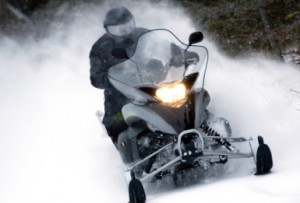Snowmobiles Explained: Staying on Track
 In yesterday’s installment, we took a look at the four main components of a snowmobile’s drive system: the engine, clutch, track and skis. We’ll shift gears slightly today to focus on the track in particular and the steering system in general. The track is designed to maximize traction as the sled moves along the snow. It could be likened to that of a tank, with one major difference: tank tracks are stiff and durable above all other considerations because of the role they play in warfare. Snowmobile tracks, on the other hand, are meant for optimal swiftness and maneuverability.
In yesterday’s installment, we took a look at the four main components of a snowmobile’s drive system: the engine, clutch, track and skis. We’ll shift gears slightly today to focus on the track in particular and the steering system in general. The track is designed to maximize traction as the sled moves along the snow. It could be likened to that of a tank, with one major difference: tank tracks are stiff and durable above all other considerations because of the role they play in warfare. Snowmobile tracks, on the other hand, are meant for optimal swiftness and maneuverability.
It goes without saying that snowmobile tracks are more effective on snow than wheels would be, but why is this so? The answer comes down to a question of physics. By spreading out the point of contact with the snow to a larger surface area, tracks create plenty of traction. The treads on the track are rough enough to create friction and grab onto the snow at regular intervals.
Snowmobiles steer in much the same way as other vehicles with handlebars. However, the steering system brings up another major difference between tank tracks and sled tracks. Tanks are often given outfitted with double tracks, which are charged with steering. Snowmobiles come equipped with twin skis at the front of the sled. The width and spacing of the skis make a significant difference when steering. Narrow skis allow a snowmobile to take sharp turns. Tomorrow we’ll take a look at the improvements that have been made to 2 cycle oil formulations.

